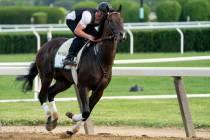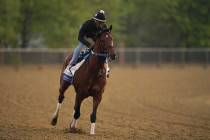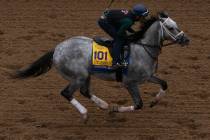Flightline’s a superstar, but is he one of sport’s greatest?
How do you measure greatness?
That’s been a topic of much discussion this week among racing fans following Flightline’s near effortless victory in Sunday’s $300,000 Malibu Stakes at Santa Anita.
By every gauge, the John Sadler-trained 3-year-old colt’s performance in the 7-furlong race was sensational.
The son of Tapit out of an Indian Charlie mare won by 11½ lengths while geared down and was never seriously challenged by any of his six rivals, including Breeders’ Cup Sprint runner-up Dr. Schivel. He ran far faster than older male horses in the $200,000 San Antonio Stakes earlier on the card, and 3 seconds (about 15 lengths) quicker than Kalypso, winner of the La Brea Stakes, the Malibu counterpart for 3-year-old fillies.
The 118 Beyer speed figure he earned was the highest awarded this year by the speed figure service, according to the Daily Racing Form. TimeformUS handicapper Craig Milkowski said the 141 he assigned to the winner was the highest sprint figure he has given in 10 years as chief analyst for the service.
The victory pushed the colt’s record to three for three, all of them cakewalks. His combined margins of victory in those starts: a whopping 37 ½ lengths.
So does that put Flightline on the list of the sport’s true greats?
I agree with what I’d say is a majority of the debaters that he hasn’t yet earned that distinction.
There’s no disputing that what he’s done so far under Sadler’s patient tutelage has been phenomenal. His Malibu victory left my mouth farther agape than in any race since Arrogate’s 2017 victory in the Dubai World Cup.
But we’ll need to see more before we can put him in the pantheon of horses like Forego, Dr. Fager, Secretariat, Ghostzapper or the most recent superstar, Gun Runner.
The good news is that the colt should get the chance to etch his name alongside those famed thoroughbreds, though he’ll likely have to do it in fewer starts than any of them, given his exploding value as a sire. Sadler told the DRF’s Steve Anderson that he and the colt’s five ownership interests are planning on racing him as many as four times next year, one of which is expected to be the Grade 1 Metropolitan Mile on the Belmont Stakes undercard in June.
Serious setback for new racing regulation
The U.S. Anti-Doping Agency (USADA) threw a big wrench into efforts to get newly enacted Horseracing Integrity and Safety Act up and running by its summer deadline, It announced Friday that it had not been able to reach an agreement with the industry panel created to implement the law.
“After months of negotiations, we have been unable to enter an agreement in line with the requirements of the Act, and one which would have given us a reasonable chance to put in place a credible and effective program,” USADA CEO Travis Tygart said in a statement. “While we are obviously saddened by the outcome at this stage, we tried our absolute best to find a way forward but without success.”
It’s not clear what happens next, but finding a quick stand-in for the respected USADA will not be easy.
Thus far no one is saying anything about the reasons for the announcement, but the cost of the rigorous new drug-testing regimen envisioned under the act is the likely sticking point.
Late scratches
Santa Anita Park proactively canceled its Thursday card due to forecasts calling for heavy rain. Racing will resume on Friday, but the three stakes originally slated for the New Year’s Eve card were moved, with the Blue Norther and Eddie Logan stakes shifting to Sunday and the Robert Frankel Stakes to Saturday to avoid likely heavy tracks. … Action heats up on the Road to the Kentucky Derby on Saturday with the $250,000 Smarty Jones Stakes at Oaklawn Park, the $150,000 Mucho Macho Man Stakes at Gulfstream Park and the $150,000 Jerome Stakes at Aqueduct for newly turned 3-year-olds.
Mike Brunker’s horse racing column appears Fridays. He can be reached at mbrunker@reviewjournal.com or 702-383-4656. Follow @mike_brunker on Twitter.
Ellis Starr's Jerome Stakes analysis
Hagler gets a great outside post for the one turn mile trip at Aqueduct in Saturday's $150,000 Jerome Stakes, which kicks off the Road to the Kentucky Derby for 2022 in New York. The Florida-bred colt appears to be the type who can be on the lead or just off the pace from the start, which is an advantage in many ways as he and jockey Jorge Vargas, Jr. can wait a few strides to see if another horse wants the lead at the start, at that point taking up a stalking position, or taking command. That is exactly what he did in his most recent race on Dec. 16 at Aqueduct where he led from start to finish. Prior to that on Oct. 29, Hagler stayed in second for the first half-mile before drawing off to win by 4 1/2 lengths. Both victories came with Vargas, Jr. in the saddle and the first of the two earned an 84 Equibase Speed Figure which, if logically improved on in his third start off a layoff, puts him in range of the top horses' figures in the field. Those top figures belong to the other two main contenders in Ohtwoohthreefive (93) and Cooke Creek (89). Trainer Rudy Rodriguez has a very good 20 percent win percentage stretching a horse out in distance at Aqueduct (per Race Lens) over the last two years, with a 38 percent positive return on investment and a median win payoff of $13. As such, I expect Hagler to win his third race in a row and put his name squarely in the Kentucky Derby picture with a big effort in the Jerome Stakes.
Ohtwoohthreefive has raced exclusively on turf to date, with a record of 1-2-2 in six races. His best effort came in his most recent race on Nov. 27 in the Central Park Stakes where he rallied to lead with an eighth of a mile to go then battled nose-and-nose to the wire, losing by inches at the finish. Nevertheless, the 95 figure earned is the best by any horse in the field. Whether that type of effort is transferrable to dirt does not appear to be a question as his sire is Union Rags, himself a talented colt on dirt, including a win in the 2012 Belmont Stakes. Additionally, trainer George Weaver has a creditable five for 16 record when moving a horse from turf to dirt over the last 12 months. Jockey Kendrick Carmouche rode Ohtwoohthreefive for the first time that day and rides back in the Jerome, and if the early pace is hotly contested this colt could be the one to get up in time and win.
Cooke Creek is the only horse in the Jerome Stakes field with a stakes win, which came at the same mile trip as this race. He won his debut when sprinting easily in September with a 76 figure then stretched out to a mile and won the Rocky Run Stakes in October, earning an 89 figure. Trying much tougher foes in the Nashua Stakes in November, Cooke Creek was no match for winner Rockefeller when second the entire length of the stretch but he was nearly three lengths clear of the next horse, earning an 86 figure in the process. With jockey Manuel Franco riding back after getting familiar with the colt in the Nashua, Cooke Creek certainly can win this race with just slight improvement off his Rocky Run effort.
The rest of the field, with their best Equibase Speed Figures: Courvoisier (85); Mr Jefferson (82); Rumble Strip Ron (77); Smarten Up (71); and Unbridled Bomber (82).
Ellis Starr is the national racing analyst for Equibase. Visit the Equibase website for more on the race or to purchase handicapping products.























